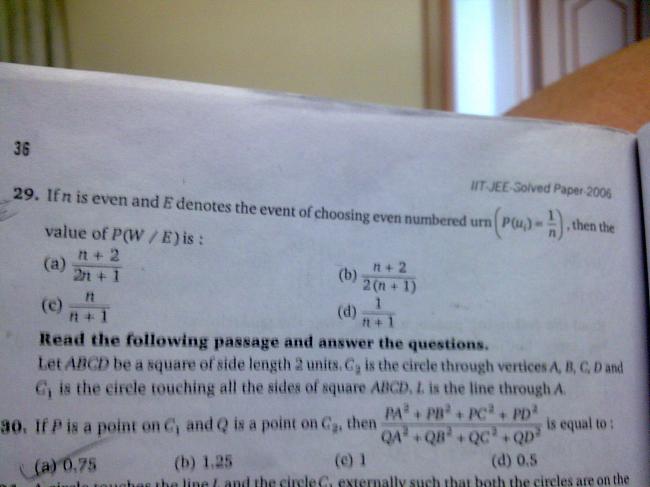k.. [1]
There are n urns each containing n + 1 balls such that the ith urn contains i white balls and ( n + 1 - i ) red balls.
Let be the event of selecting ith urn, i = 1, 2, 3 ..., n and
w denotes the events of getting a white ball.
Q1. If P( u_i ) i , where i = 1, 2, 3, .... n,
then is equal to ?
(a) 1/4
(b)2/3
(c)1
(d)3/4
-
UP 0 DOWN 0 0 20

20 Answers
@tapan... for 29th question, i'm getting d answer as B...!!!
my solution isn't worth posting... did something, got dis answer... :D
for d second one...
P(Ui)=c
P(Un/W) = P(Un∩W)/P(W)
P(Un∩W) = c(n/n+1) .....
P(W) = c(Σi/n+1) = c(n/2) ... (probability of selecting any bag is 'c' and probability of selecting a white ball from ith bag is i/n+1... summing up all probabilities gives n/2)
therefore P(Un/W) = 2/n+1...........
well, for d first one...
P(Ui)=ki
now, ΣP(Ui)=1 ....... (since sum of d probabilities of selecting each bag = 1 as there are no other cases left)
=> k. Σ i = 1 => k=2/n(n+1)
now P(W) = k.(1/n+1) + 2k(2/n+1) + 3k(3/n+1) + ... + nk(n/n+1)
=> P(W) = 2/n(n+1)2 [n(n+1)(2n+1)/6] = 2(2n+1)/6(n+1)
now applying lim(n→∞)... we get P(W)=2/3.....
Can sum1 pl. show the crrct working for 2nd one.......
well tjer was a 3rd part as well........... Q29

okay sparkle .........
P(Ui) = Ci (c= constant)
ok ?
now , have the general value of C
then find the conditional probability of W given Ui
ok ?
and P(W) as the function of "n"
bas thats it !!
at last apply the formula for the sum of the first n positive integers.
thanks,please go through the link given,maybe at least you can make some sense out of it.
i know its bad ....
and u are 99% correct...
but am 1% correct with the thing that in xam hall wid three mins at hand
its useless going into the concepts and solving a question fully...
but ofcrse here we can do it...
i will post if i get something..
watever ..
it is not the question of getting the answer,i want the concept behind it...what if they give constraints like 2000<n<10000
you can't plug the values and get the answer.
hey i believe in one thing ... wenevr there are sums wid 'n' things and all...
take values ...
at least to chcek wats happenening...
cos wid 'n' things,,, its very hard to imagine...
m giving u the link to the solutions,
ill be glad if sm1 explains them to me..
http://www.scribd.com/doc/2227207/IITJEE-Solved-Mathematics-2006
21st q frm comprehension
for the second one,
the ans is A i hope...
put n=1.
then no of balls = 2 -> 1 white, 1 red.
then P(un ∩ w) = 1/2
and P(w)= 1/2
so, ans=1.
now, in the options, put n=1.
[ if u wanted the method... then .. i cud post later... ]
since this is objective,
(though i havent read the question fully)
but one trick is: put n=2. and solve ,,, and chcek in the ans ... putting n=2..